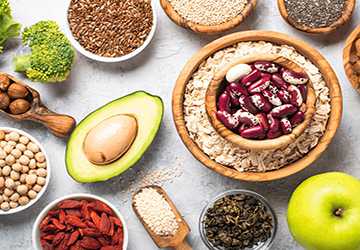What Are the Benefits of A High-Fiber Diet
The importance of fibre has become vital in current health conversations. A high-fibre diet combines the benefits of fibre with optimized gastrointestinal function, skilled weight management, and powerful prevention against various diseases. This talk explores the need to include high-fibre foods and their transformative impact on overall health.

Benefits of a High Fiber Diet
Advanced gastrointestinal function
One significant benefit of a high-fat diet is improved gastrointestinal function. Fibre can improve stool bulk and flexibility, making bowel movements smoother and reducing the occurrence of constipation. Additionally, it enhances intestinal integrity and acts as a bulwark against diverticulitis.
Weight management knowledge
Why choose fiber-rich foods? These eating habits are lower in calories and produce fewer calories than they contain. In addition, fibrous foods are chewed more slowly, creating a sustained feeling of fullness and helping to alleviate overconsumption.
Blood sugar balance.
Fiber regulates the absorption of sugar, thereby helping to stabilize blood sugar levels. This is crucial for controlling diabetes because it suppresses post-meal blood sugar spikes. Soluble fibre improves insulin sensitivity.
Strengthen cardiovascular.
A high-fiber diet may reduce the risk of cardiovascular disease. It helps lower cholesterol levels and relieves blood pressure and inflammation.
Improve immune system efficiency.
Strengthen the immune system.
A fibre-rich diet can significantly improve your immune system's performance. Fibre nourishes your gut microbiome, which supports a strong immune defence. A diverse microbiome continuously nourished by fibre enables the body to fight infection and reduce inflammation, becoming a staunch defender against countless health challenges.
Effects of fibre on microbiome heterogeneity
Fibre-rich foods increase the diversity and vitality of your gut microbiota, which is critical for digestive processes and the effectiveness of your immune system. The microbiota balance supports the synthesis of natural antibodies and strengthens the mucosal barrier against pathogen invasion.
Improve cognitive health.
Clarity and emotional balance
Groundbreaking research shows a link between fibre consumption and brain health. By promoting a healthy gut environment, fibre may indirectly enhance cognitive performance and reduce the risk of cognitive decline as we age. A healthy gut can positively impact mood states through the gut-brain axis, suggesting that a high-fibre diet may improve mental health and emotional stability.
Nervous system benefits of a high-fiber diet
A high-fiber diet can benefit the gut-brain axis, the complex communication network that connects the gastrointestinal tract and the brain. Metabolites produced by fibre digestion have anti-inflammatory properties that may benefit brain health and overall neurological function.
Extend longevity and improve quality of life!
Eating habits can extend life.
Research consistently shows that a high-fibre diet is associated with a reduced incidence of a variety of chronic diseases, including certain cancers and cardiovascular diseases. People who eat a lot of fibre tend to have lower mortality rates, suggesting that a high-fibre diet can lead to a longer, more energetic life.
Improvement in quality of life
A fibre-rich diet can extend one's lifespan and improve one's quality of life. These benefits include improved physical health through effective weight management, reduced disease risk, and improved mental health through optimal gut health.

Why choose fiber-rich foods?
Fibre-rich foods, such as fruits, vegetables, legumes, and whole grains, have many health benefits and are rich in essential micronutrients. They can create a balanced diet.
Examples of fibre-rich foods
●Whole grains: oats, barley, and quinoa
●Vegetables: carrots, beets, broccoli
●Fruits: apples, berries, and oranges
●Pulses: lentils, chickpeas, and black beans
Strategies to Increase Fiber Intake
incremental integration
For those new to a high-fiber diet, it is necessary to increase intake gradually to avoid gastrointestinal upset.
Improve hydration.
Since fibre is hygroscopic, increasing fluid intake is essential to facilitate its passage through the digestive system effectively.
Diversified sources
Incorporate various sources of fibre into your daily meals to prevent boredom while eating and ensure a balanced nutritional intake.
Comprehensive meal plan
●Variety and inclusion: Try to include fibre-rich foods in every meal to ensure each dish significantly contributes to your daily fibre goals. Consider fibre-rich breakfast options like oatmeal or whole-wheat buckwheat pancakes, a hearty stew for lunch, and healthy grains like quinoa or bulgur for dinner.
●Watch your snacks: Choose fibre-rich snacks, such as crunchy raw vegetables paired with delicious hummus, juicy fresh fruit, or healthy nuts. These snacks provide essential nutrients and ensure optimal energy levels throughout the day.
High-fibre formula adopted.
●Recipe modification: Change traditional recipes by substituting nutrient-rich, fibre-rich ingredients. For example, use whole grain spelt flour in baking, add flax seeds to refreshing smoothies, and add hearty lentils to delicious meat products to increase their fibre content.
●Flavor combinations: Try using a range of aromatic spices and herbs to harmonize with the natural flavours of fibre-rich foods. This enhances food enjoyment and adds an element of variety to your cooking, making it more enjoyable and consistently satisfying.
Education career
●Learning Opportunities: Through comprehensive literature, reputable online platforms, or enriched nutrition workshops, embark on a self-educational journey about the origins and benefits of different fibre types (such as soluble or insoluble). This store of knowledge empowers you to make informed nutritional decisions based on your needs.
●Community Engagement: Participate in or lead community cooking collaborative meetings focused on creating hearty, fiber-rich meals. Sharing insights and experiences in collaborative events like this can serve as a powerful catalyst, igniting the fire of motivation and inspiration among participants to encourage healthier eating habits.
Long-term commitment to fibre intake
●Goal setting: Set achievable, quantifiable fibre consumption goals and monitor your progress carefully. This may mean gradually increasing your daily fibre intake until you reach the recommended levels.
● Regular health check-ups: Participate in routine health check-ups with a healthcare professional to advise and adjust dietary habits based on health and nutritional assessments.
Conclusion
The importance of fibre in the diet is crucial. Benefits include making it easier to maintain healthy digestion and preventing chronic disease. You can reap these wide-ranging health benefits by consciously including more fibre-rich foods. This can improve your physical health and improve your overall quality of life. Remember, even small dietary changes can lead to significant health improvements.







